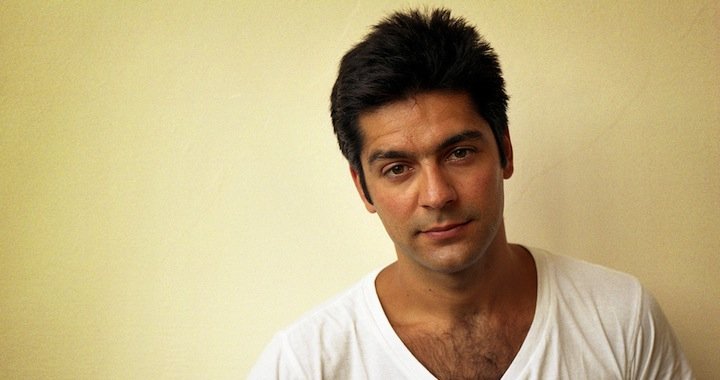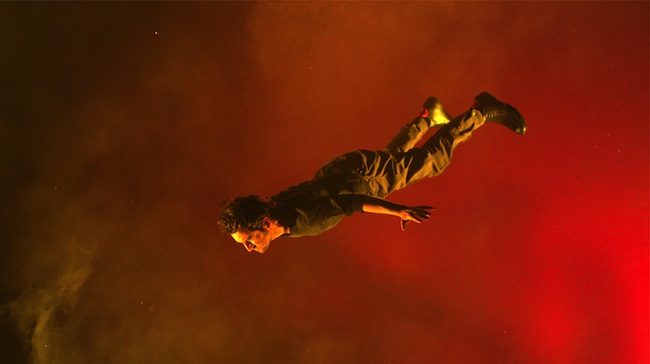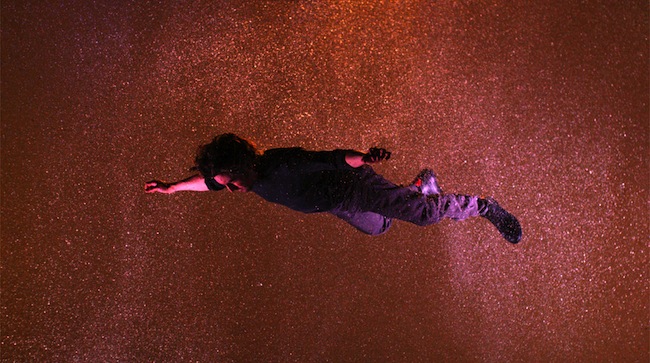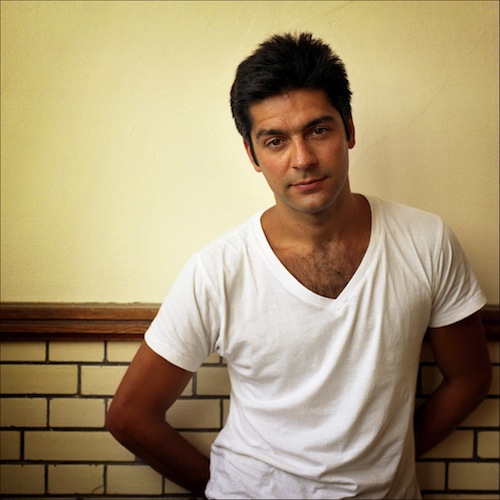
Between Reality and Fiction
03/03/2014
Under the title of “Ficconario”, five works by Argentinian video artist Sebastian Diaz Morales (1975) – “Oracle” (2008), “Pasajes” I & II (2012, 2013), “Insight” (2012) and the very recent “Suspension” (2014) – are being shown at the Contemporary Art Centre (CAC) in Vilnius, through March 16.
The Argentinian video artist Sebastian Diaz Morales (1975) currently lives and works in Amsterdam. After studying at the Universidad del Cine de Antin film school and post-graduate work at the Rijksakademie van Beeldende Justen (The Royal Academy for Visual Arts ) in Amsterdam, and then a period of residency at La Fresnoy in Roubain (The National Contemporary Art Studio) in France, Morales began his tour of solo shows – starting in the USA and Mexico, and then on through numerous European cities. Awards and stipends of various caliber followed one after the other, including a Guggenheim Stipend in 2009. Since 2000, the young artist's works have been exhibited at Amsterdam's Stedelijk museum, New York's Art in General, Barcelona's Miro Foundation, London's Tate Modern, and Paris' Centre Pompidou, among others. The last two have acquired works by Morales, while other works have found a place among private collections such as The Sandretto Re Rabaudengo Foundation and The Francois Pinault Collection – both in Italy, The Goetz Collection in Germany, and the Isabelle and Jean-Conrad Lemaitre Collection in France.
Morales' film and videos are often times surreal – social reality reflected in a form that is visually abstract and fantasy-based. Most of the works study the relationships between a large-scale socio-political power and the actions of individuals; they reflect the interactions between people and their environment and social structures.
The methods that Morales uses are twofold – in his works he uses both prepared scripts and the uncertainties of real life. His camera is focused on capturing documentary material, but he also uses footage that is experimental and that comes from the realms of science fiction. Morales' arsenal of techniques includes working with material that he has filmed himself, as well as using and transforming footage taken by others.
I met with Sebastian Diaz Morales at the Contemporary Art Centre in Vilnius, just a couple of hours before the opening of his show...
How do you feel now that everything is in its place and the exhibition has become a whole?
This exhibition was set up according to a strict plan, and left little room for improvisation. In a sense, it's like a film that follows a carefully written script. I am satisfied – a plan like this really works; otherwise, if I become too engaged with the design of the exhibition, it could lose its meaning. But now it has relevance.
“Pasajes I” (2012). A dissecting room, a grocery store, a museum, a cellar... In opening the doors from one room to another, the sense of a real place breaks down while the image of a non-existent space takes its place.
Before we turn to discussing the finer points of the exhibition, I'd like to know how large of a role does the space play – the intrinsic architecture...
In truth, this space was a challenge. This is the first time I'm exhibiting in such a large space. I wanted to leave it as free and open as possible, while at the same time, to take advantage of the physical structures of its architecture. In reference to “Pasajes I”, in which a young man keeps opening one door after another, it seemed like a wonderful idea to build a wall with a door, and when the visitor walks across the room to go through the door, he is also crossing the boundary that leads into another dimension.
The works behind every wall are very different, and they reveal the variety in which I create fiction.
Speaking of fiction, I found the idea mentioned in the press release – that the balance between reality and imagination has been lost in today's world – rather interesting. Namely, that the imaginary is already right here, and that the artist's job is to create reality. Contemporary artists are turning towards documentary forms of expression, and screenplays are based on the existing social reality. What could this mean? Is it some sort of paradigm shift?
Today reality is manipulation. In a certain way, it already is imaginary. Reality has been created the way we want it to be. In truth, we're directing it ourselves. We assign meaning and order to things, and that's how we comprehend them.
In most cases, however, people assign just one meaning to things, and they're not open to different interpretations. When I turn to reality, I change it, I manipulate with it, I try to discover new conceptual meanings. For instance, in the pieces “Pasajes I” and “Pasajes II” – in which behind every next door the young man enters an environment that has absolutely no connection to the previous one, or he climbs a never-ending labyrinth of stairs – I've used a very simple formula in which to create a surreal fantasy. In this way I manipulate in order to construe another possible reality.
In this sense, what I do is far removed from the trend that you mentioned – the documentation of reality. Nevertheless, I, too, am interested in breaking reality – making it clear and transparent, and opening the gate to another level in which we understand it.
Are you satisfied with the reality in which you live?
I am critical. I look at things from a critical viewpoint and believe that there is much that could be changed. This is especially true in the place from which I come. The city that I've always extolled is currently not headed in the best of directions. That's why I try to be useful by attempting to construe another reality – a better reality – through that which I do. To be creative and to fantasize is a way in which to live an everyday kind of life while also changing your surroundings.
You tend to look at reality through the prism of irony. That can't be the easiest of ways to portray it. One has to be very experienced and smart – and have a good sense of humor – to do that.
There are films in which I use comedy or irony, but it happens naturally, and I don't especially concentrate on it. I know that one has to be very clever in order to not make the irony too obvious.
It's important to be able to look at things with a smile, to laugh an oneself, to create metaphors and to speak ironically about what we are and what we are like. That way we can learn something new.
Do you wish to change the way in which people look at reality?
I want people to know that there are always various choices, various possibilities. While I am able to fill in the blanks – to show that there is a slightly different way to look at the world – my work is suitable and I am at peace.
How important is it to you that the public understands your work?
That is the most important thing to me. It think about that a lot. Sometimes my work can be understood better by one audience than another.
I first saw your works on vimeo.com, and there I noticed that many of them have been supplemented with stories and text; and rather philosophical ones, at that. Does the viewer need to be armed with this knowledge beforehand to understand your work and its message?
Not quite. I work according to classic film-making prerequisites, and the language of cinema can be comprehended without additional content. Although what you're saying is true, and many of the works simply ask for additional background information about their conception, I think that if the viewer is on the same wavelength in terms of reality and fiction, the work can also be comprehended without it

Stills from artist's latest work Suspension (2014)

Do you make room for the public's interpretation?
Definitely. For example, the video work “Suspension”, which I finished a couple of weeks ago and which is currently on view in the exhibition... in it, the young man is hanging in the air, maybe falling... And there isn't any special or definite way in which to understand it. At the same time, if I revealed a story – there's no saying that that's what the audience would see in it. I don't try to show or prove a certain idea; I like it when the viewer interprets it freely.
What is the story in “Suspension”?
We are not in reality, we're just dreaming. We're drifting somewhere in time and space.
You tend to be influenced by the literary genres of fantasy/reality and science/fantasy... Who are your favorite authors?
You can find references to many of them in this exhibition. James G. Ballard, Roberto Arlt, Julio Cortazar – who, by the way, was married to a Lithuanian, and which is probably why I didn't hesitate when I was approached to do this exhibition...
When watching the video-work “Oracle”, I was astounded by your ability to notice the uncommon, the unusual. Is that just a stroke of luck, or is talent involved?
I am curious – I study the surroundings, I look for the uncommon. This work is a compilation of small moments captured over ten years. It's made up of forty-five scenes, and each one has its own story for me. I once saw a headless statue by a church, and I noticed how the pigeons would land on its neck, thereby making a head for it. I went there several times, waiting for a pigeon to land on this injured statue and giving it a moving head. Every day was different – different colors, different noises. Now I live in a much more boring place and I don't need a camera, but I traveled a lot back then, and I always had a camera with me.
You make much use of closeups in your work.
Yes, I like to do that. Many people don't use them. I like to zoom in – the image becomes pixelated, almost like a painting.
In “Oracle”, I zoomed in on two planes that were flying very close to another for a long time. Two planes flying next to each other at the same speed – you don't see that very often! Upon zooming in, I saw that one was from a Chinese airline, and the other from a South Korean firm.
You can't afford to simply wander and observe anymore for those works of yours that are based on screenplays...
I'm very flexible and I can change the way in which I work. I like to work much like in documentary film-making, but in films that have a screenplay, such as in “Pasajes”, underneath there still is a sense of searching, of wandering and observing. The labyrinth of stairs and doors is made up of a combination of all of the places in which I've been – a slaughterhouse, a cemetery, universities, boxing clubs... All of these places are a part of the hidden Buenos Aires; one must look for them.
These days, the city if far from this fantasy that I have created.
The young man navigating this vertical labyrinth of stairs is my good friend, Federico Zukerfeld, a surrealist. I met him on the street. It was important for me to not use an actor, but a person who truly believed me, who believed in what was on the other side of the doors and in another dimension, in another world... And so I asked him to do it. Federico didn't have to do much acting – he simply had to open the doors, believing that he would then be entering another world.
“Pasajes II” (2013). Single staircases, spiral staircases, twisting staircases, employee stairwells, emergency stairwells; made from wood, from stone... His footsteps ringing on the concrete flooring, the protagonist moves with a sure and steady stride. Through video editing, the artist has transformed urban spaces into a new and fictional cityscape; he has created his own reality, parallel to the one that we take to be real.
Do you ever work with actors?
No. For example, in the video work “Suspension”, the main character works in a movement theater company. In this case, I needed someone who was comfortable working with ropes – someone who really understood what he was doing. I found him myself, the day before we started filming. He could do the technical aspects of the job, but at the same time, he completely understood the idea behind it all – the falling, the hanging in outer space, the dream, and the fictionality of it. That is something to be valued; I want to believe that the actors continue in this same line even afterwards, and that they don't simply do a deodorant commercial the next day and we no longer have something in common.
The same goes for the film crew. It is very difficult to find people with a similar way of thinking. That's why most of my crew doesn't know anything about making films. My crew is made up of my friends, my brother, my mother and father, the neighbors... It's always an environment that is close to me. I favor those who understand me naturally – without me having to give direction. The technical aspects aren't that complicated these days – the lighting and sound... we can get by with that. A unified vision, goal and state of mind are the most important!
What is your greatest discovery in the medium of video and film – your most technically successful experiment?
I don't know if it's worth talking about the technical side, but the main thing that I've discovered is the ability to naturally and fully comprehend the medium. To be able to work with the camera as if it were an extension of your mind and eyes. That is the most difficult thing to achieve – to meld into one with your instrument.
How would you describe the current mood in the video art scene?
I have a feeling that a large part of what I'm seeing follows some pre-set, given formula.
Truthfully – I may make videos, but I don't really watch them.
At the same time, I don't want my work to be filed in the category of video art and theory. What I do is a mixture of various languages, structures and images that have been set into an audiovisual form.
If I may be so bold as to ask you about the commercial aspect of this art form – Are collectors interested in it?
Yes and no. There definitely is interest in my work, however, since it is a hybrid between film and video, it is about fiction; it is possible that it doesn't quite fit into the contemporary art arena. In addition, I'm not consequential in my creative work, but in contemporary art, I think there's a tendency to follow along to see if an artist stays true to his chosen line – if he keeps to a certain shape and format.
But I've been lucky in having my work valued, and in the fact that I can support myself with it.
Could you name some of the collectors who have shown interest in your work?
One of my recent works, “Insight”, was acquired by the François Pinault Foundation; other works are in the collections of the Tate Modern and the Centre Pompidou, as well as in private collections such as The Goetz Collection and the collection of Isabelle and Jean-Conrad Lamaître. This last collection makes itself widely accessible to the public – they organize exhibitions and support artists. I'm happy that my works are part of collections that I think very highly of myself. I respect collectors that understand my work because it is very specific – it requires a special sort of exhibiting, and it is clear that collectors aren't following any market directives by acquiring it.
I was very happy when I sold the “Pasajes” series because most people have a definite perception of Buenos Aires, and it's important to me how they'll perceive it now – after watching my piece.
Is your art cosmopolitan, or nationalistic?
It is universal. It is existential, humane. It touches upon questions that we try to find answers to every day. Sometimes I try to be understood and useful to a certain audience; I'll speak to a very local public, like in the work “Pasajes”, for instance.
Are you confident in yourself as an artist, as a professional?
Yes, but I'm not a serious professional; I play with what I do. I work naturally.

If you could create a museum for your works, or any other sort of foundation – what would it be like?
It could be a work that contains other works. It could be, for instance, a tree fort – like a shelter or cabin that would fit in naturally. It would be made of the same material, possibly from the same tree. This cabin would have two different windows – from one you could see reality, the way it is in my films; from the other, which faces upwards to the tree canopy, you could see a much more abstract view of my works. There's an etched drawing somewhere that shows another cabin. It is round. Inside there are stories and pictures, and characters, and various voices and moods – my works are also inside. There's a third cabin – somewhere in the city. This one is a normal house in which I live and do all the normal things one does at home.
This is a metaphor that explains my work – this physical cabin is a concentrate of my work and my vision.